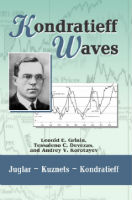
|
Kondratieff waves:Juglar – Kuznets – KondratieffBibliography: Volgograd: ‘Uchitel’ Publishing House, 2014. – 416 p.
Edited by: Editors:
Leonid Grinin (Russia), Tessaleno Devezas (Portugal), Andrey Korotayev (Russia) ISBN 978-5-7057-4282-0 Editorial Council:
Editorial Council: Askar A. Akaev (Russia – Kyrghyzstan), Brian J. L. Berry (USA), Valentina M. Bondarenko (Russia), Tessaleno C. Devezas (Portugal –Brazil), Claude Diebolt (France), Sergey Yu. Glazyev (Russia), Ruslan S. Grin-berg (Russia), Bert de Groot (Netherlands), Masaaki Hirooka (Japan),
Boris N. Kuzyk (Russia), Witold Kwasnicki (Poland), Francisco Louçã (Portugal), Vladimir I. Maevsky (Russia), Leo Nefiodow (Germany), Carlota Perez (Venezuela – UK), Sanjay Prasad (India), Arno Tausch (Austria), William R. Thompson (USA), Andrew B. Tylecote (UK), Yuri V. Yakovets (Russia)
|
In the period from the 1920s to 1930s the theory of economic cycles underwent dramatic changes. Due to the research of such famous economists as Nikolay Kondratieff, Joseph Kitchin, Wesley Mitchell, Simon Kuznets, and Joseph Schumpeter the idea of a whole system of economic cycles (with characteristic periods between two and sixty years) was developed. The idea of a system of intertwined economic cycles is nowadays paramount to the school of evolutionary economics and its development promises rather interesting future outcomes. That is why this issue of our ‘Kondratieff Waves’ Yearbook is devoted to the interconnections between various economic cycles. As to the subtitle of this volume, one should note that many of the contributors refer to the system of cycles and the fact that real economic cycles make up a system, whereas among different types of cycles, the Juglar, Kuznets, and Kondratieff cycles are the most important ones for the present-day economic dynamics.
Although Kondratieff himself considered long waves as above all an economic phenomenon, the theory of the long waves became, however, very actively developed in connection with their political and geopolitical aspects. In this Yearbook, the political aspect of Kondratieff waves is the subject of several articles in the second section.
The last section of this Yearbook is devoted to the heritage of Kondratieff and other prominent economists. The year 2015 marks the 150th anniversary of the outstanding Russian economist, one of the most prominent researchers of medium-term economic cycles, Mikhail Tugan-Baranovsky, and the volume is concluded with Kondratieff's article about him. Concerning 2015, we should mention another anniversary, namely, 30 years since the death of Simon Kuznets (1901–1985).
This edition will be useful for economists, social scientists, as well as for a wide range of those interested in the problems of the past, present, and future of global economy and globalization.